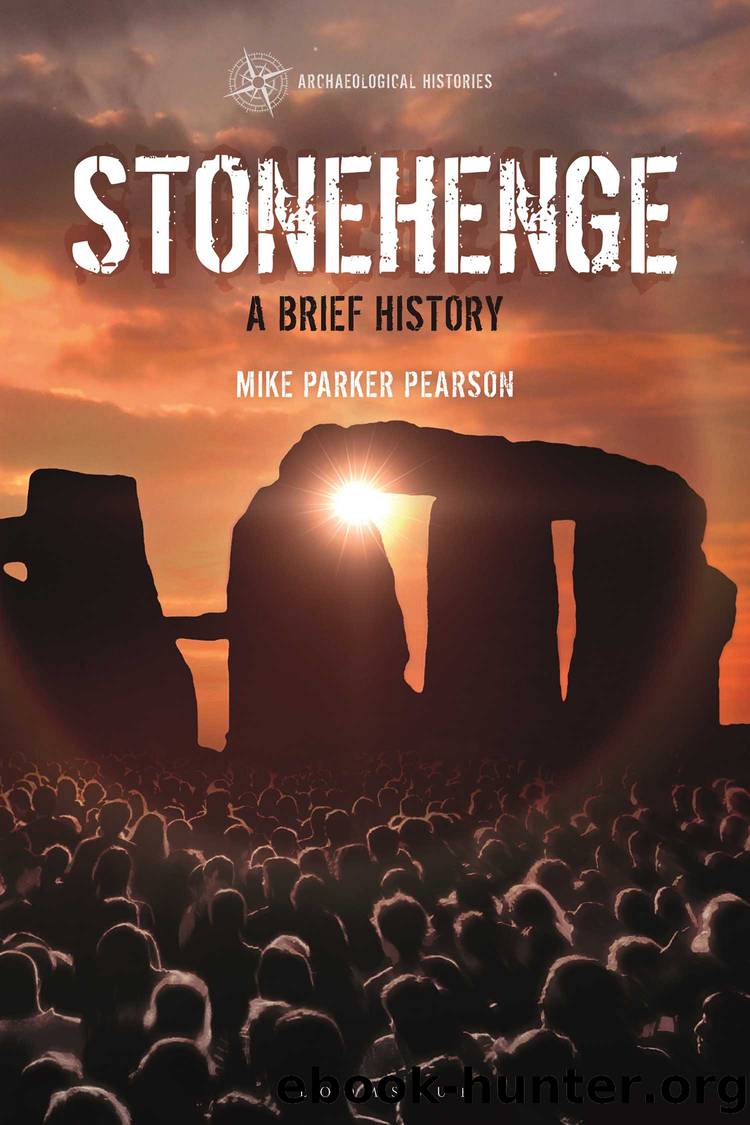Stonehenge by Mike Parker Pearson;

Author:Mike Parker Pearson; [Pearson, Mike Parker]
Language: eng
Format: epub
ISBN: 9781350192256
Publisher: Bloomsbury UK
Published: 2023-01-18T00:00:00+00:00
Figure 7.4 Reconstruction of the burial in Bush Barrow: (1) fragments of bronze dagger; (2) bronze axehead; (3) two bronze daggers with gold-studded hilts and a gold belt hook cover; (4) bronze knife; (5) gold lozenge-shaped plaque; (6) mace with small gold lozenge-shaped plaque (from Needham et al. 2010a, courtesy of Stuart Needham).
Part of the gold-covered handle of the shorter of the two daggers survives, and it is extraordinary. It was decorated with as many as 70,000 tiny gold studs set into wood very close together, in an attractive decorative pattern of chevrons (Corfield 2012; Woodward and Hunter 2015: 242â5). The other daggerâs handle was decorated with gold studs encircling the rivets that attached it to the blade (Corfield 2012). The minute size of the gold wire studs â each one is only around 1 millimetre long and ¼ millimetre in diameter â reveals that the maker of these dagger handles had enormous patience and precision as well as phenomenally good vision, perhaps even augmented by magnification with a simple lens of transparent rock crystal. The daggers were probably imported from Brittany, where daggers from a number of burials have similar gold-studded handles (Corfield 2012).
A hundred miles to the west, just south of the large stone-walled Bronze Age settlement enclosure of Grimspound on Dartmoor, someone was buried with a similarly decorated dagger under a round barrow on Hamel Down. Its pommel was made of Baltic or North Sea amber into which hundreds of gold studs had been inserted to form a cross-shaped pattern (Pearce 1978: 47). Intriguingly, the rock source of the Bush Barrow macehead is from this area of south Devon, as little as 10 miles away from Hamel Down (Woodward and Hunter 2015: 248).
Of the other forty or more barrows on Normanton Down, three (Wilsford G7, G8 and G23) were erected over the burials of lavishly accompanied individuals. The cremated bones of one person were laid on the ground surface and then covered by a bell barrow (Wilsford G8; âbell barrowsâ have steep sides and so look bell-shaped in profile). This individual â possibly a woman â was provided with a conical pendant covered with sheet gold, another pendant in the form of a gold, amber and bronze halberd, two more gold-sheeted amber pendants, and various beads and ornaments of gold, bronze, shale and bone (Woodward and Hunter 2015: 229â31). The person whose cremated remains lay beneath Wilsford G7 (again, possibly a woman) was provided with an axe-shaped pendant of jet, a gold-covered shale sphere, amber pendants and other components of a necklace. Amber came from the North Sea or the Baltic and the jet came from Whitby on the Yorkshire coast. Near the western end of the Normanton Down cemetery, a bowl barrow (G23; a âbowl barrowâ is a shallow-sided mound, like an upturned bowl) was erected over the cremated remains of an individual equipped with a bronze dagger and knife, a dress pin and belt hook both of bronze, a bone flute, and a perforated whetstone of a type of rock found in Devon and Cornwall.
Download
This site does not store any files on its server. We only index and link to content provided by other sites. Please contact the content providers to delete copyright contents if any and email us, we'll remove relevant links or contents immediately.
The Daily Stoic by Holiday Ryan & Hanselman Stephen(3158)
The Fate of Rome: Climate, Disease, and the End of an Empire (The Princeton History of the Ancient World) by Kyle Harper(2932)
People of the Earth: An Introduction to World Prehistory by Dr. Brian Fagan & Nadia Durrani(2647)
Ancient Worlds by Michael Scott(2541)
Babylon's Ark by Lawrence Anthony(2465)
Foreign Devils on the Silk Road: The Search for the Lost Treasures of Central Asia by Peter Hopkirk(2396)
The Daily Stoic by Ryan Holiday & Stephen Hanselman(2391)
India's Ancient Past by R.S. Sharma(2335)
MOSES THE EGYPTIAN by Jan Assmann(2313)
The Complete Dead Sea Scrolls in English (7th Edition) (Penguin Classics) by Geza Vermes(2175)
Lost Technologies of Ancient Egypt by Christopher Dunn(2148)
The Earth Chronicles Handbook by Zecharia Sitchin(2123)
24 Hours in Ancient Rome by Philip Matyszak(1997)
Alexander the Great by Philip Freeman(1987)
Aztec by Gary Jennings(1901)
The Nine Waves of Creation by Carl Johan Calleman(1812)
Curse Tablets and Binding Spells from the Ancient World by Gager John G.;(1792)
Before Atlantis by Frank Joseph(1761)
Earthmare: The Lost Book of Wars by Cergat(1737)
